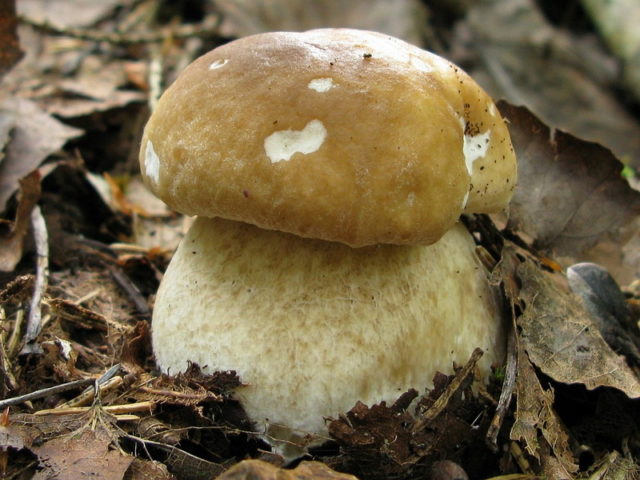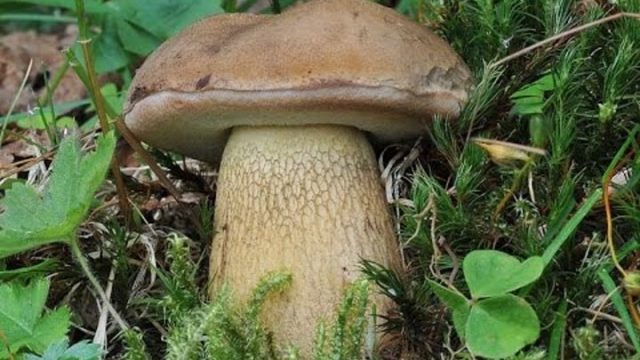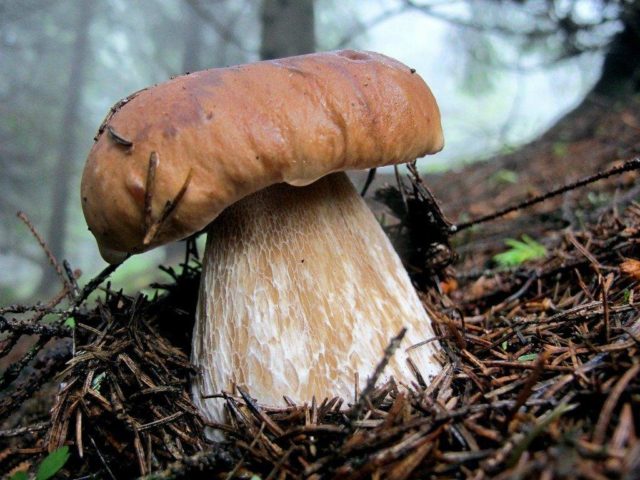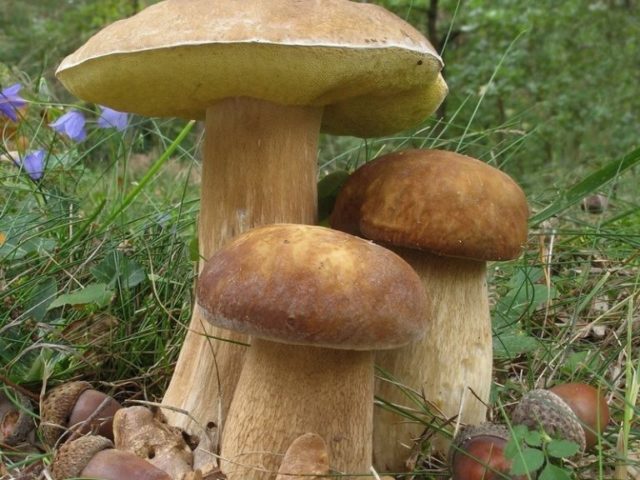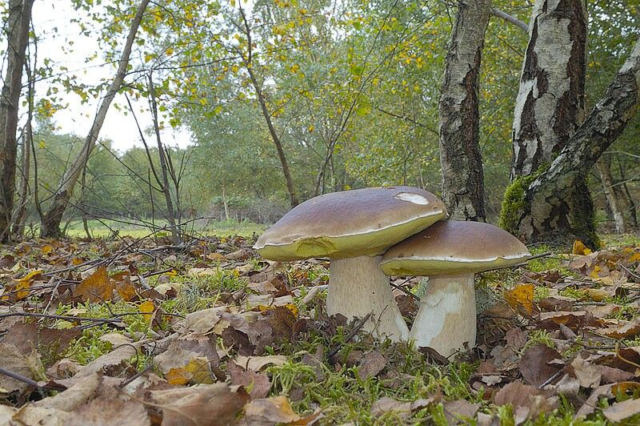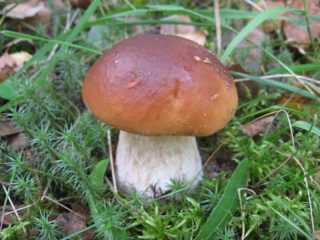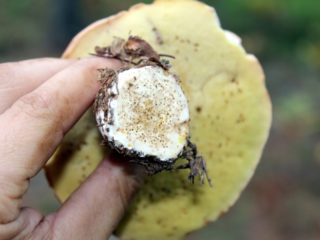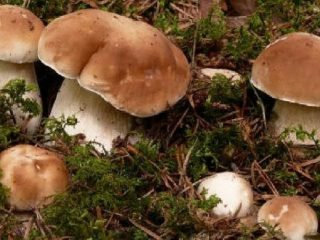Content
White birch mushroom is highly valued for its pleasant taste. But in order to correctly recognize it in the forest, you need to study the description of this species and its photographs, as well as false doubles.
What birch boletuses look like
White birch mushroom is also called spikelet, since its fruiting occurs at the time when rye begins to ripen. The species has a large cap, characteristic of pains, hemispherical or pillow-shaped in adulthood, reaching 15 cm in diameter. The skin on the surface of the cap is smooth or slightly wrinkled, shiny, but not slimy. In color, birch aches are usually light yellow or whitish-buffy, sometimes fruit bodies with an almost white color come across.
Below, the cap of a birch painter is covered with whitish or light yellow tubules in adulthood. The pulp on the break is whitish, dense in structure and with a pleasant mushroom smell.
According to the photo and description of the white birch mushroom, it rises above the ground up to 12 cm, and its leg reaches 2-4 cm in girth. The leg is dense in shape, similar to a barrel, whitish-brown in shade with a distinguishable light mesh in the upper part.
Where birch porcini mushrooms grow
You can meet the species almost throughout the country. But more often it comes across in northern regions with a rather cold climate - in Siberia and the Murmansk region, in the Far East. White birch sore chooses mixed forests and birch groves for growth, appears most often under birch trees, but can also grow near other deciduous trees. You can see the spikelet on the forest edges and not far from the road shoulders.
Is it possible to eat birch porcini mushrooms
The birch spikelet is completely edible and tastes great. After boiling, it is consumed in any form - boiled and fried, pickled and salted. Also, white birch pain can be dried without boiling, then it can be used for a long time after collection.
Interestingly, even after drying, the spikelet remains white, its flesh does not darken or turn brown.
False doubles
The birch spikelet can be confused with some other species. Basically, false doubles are edible or conditionally edible, in these cases the error will not lead to unpleasant consequences. However, the spikelet also has counterparts that are not suitable for food consumption, and special care should be taken here.
Gall mushroom
The bitter mushroom, or bilious, is very similar to many representatives of the Boletov family and therefore often ends up in the basket of inexperienced mushroom pickers. The gorchak is similar in appearance to a birch mushroom. It is also characterized by a pillow-shaped or hemispherical cap at a young age with a lower tubular layer, a strong leg and a yellowish-brown skin tone.The species are similar in size - the bitterness rises above the ground up to 10-12 cm and grows up to 15 cm in diameter.
But at the same time, there are important differences between the varieties:
- The cap of the bitter pot is darker, and it is easy to remove the skin from it, while in the white birch cap it is difficult to remove.
- There is a mesh pattern on the stem of the gall fungus, but it is not light, but darker against the background of the main color of the stem.
- The lower tubular surface of the bitterness is white or pinkish; if you press on the spongy layer, it will clearly turn pink.
- The bitterness pulp at the break changes color, it becomes pink, but the birch spikelet does not change the pulp of the white shade.
- If you lick the mushrooms on the cut, then the spikelet will have a neutral taste, and the bitter one will be very bitter.
Spruce white mushroom
This species is a close relative of the birch white painter and therefore is very similar to it in external structure. The species combine a hemispherical or pillow-shaped cap of the same shape, dense legs and a tubular bottom layer.
But you can distinguish a spruce pain by several characteristic features. His hat is darker, closer to chestnut brown. In addition, the species differ in their habitat - white spruce is also found in deciduous plantings, but it can be seen much more often under spruce trees, in coniferous forests.
The spruce mushroom is good for human consumption. Distinguishing it from white birch is simply necessary to improve your mushroom picking skills.
Common boletus
In the absence of experience, you can confuse a white birch mushroom with an ordinary boletus. The species are similar to each other in a hat - in a boletus it is also large and pillow-shaped, up to 15 cm in diameter.
However, there are far more differences between species than similarities. Boletus is usually darker in color, its color is closer to chestnut, although yellowish-buffy fruiting bodies are also found. In damp weather, the cap of the boletus becomes covered with mucus. The easiest way to distinguish the species is by the leg - in the boletus, it is covered with characteristic dark gray scales, which are not found in the white birch pain.
The boletus is a good edible mushroom, and there is no danger of a mistake in itself. However, it is very desirable to distinguish between mushrooms.
Oak porcini mushroom
A close relative of the spikelet is the white oak ache. They are similar in structure to each other - the oak mushroom also has a semicircular pillow-shaped cap of the same size, a thick leg with a light mesh pattern. Oak white grows in deciduous and mixed forests, it is more often found under oaks and beeches, but sometimes it can grow under birches, which increases the likelihood of error.
You can distinguish the species, first of all, by the shade. The oak white cap color is darker - from light ocher to coffee. The leg is of the same shade, whereas in the spikelet it is much lighter, closer to a whitish-yellow color. The oak porcini mushroom is completely edible, so it is not dangerous to confuse the varieties.
Collection rules
It is recommended to go to the forest for spikelets from the end of July, and they grow mainly until the end of September. For collecting spikelets, you should choose clean forests located at a distance from major roads, railways and industrial areas. Since the mushroom pulp intensively absorbs toxic substances, the fruit bodies collected in the polluted area will not bring health benefits.
When collecting, it is necessary to use a sharp knife and cut the mushrooms along the stem not high above the ground. You can also gently unscrew the white birch paints. It is necessary to ensure that the underground mycelium of the fruiting body does not suffer, otherwise the spikelet will no longer be able to grow again in the same place.
Use
Edible white birch mushroom is used in almost all cooking options.Since it is still not recommended to eat the spikelet raw, it must be processed after harvesting.
The preparation consists in the fact that the fruit bodies are cleaned of all adhering forest debris, washed under cold water, and then boiled together with salt for about 15-30 minutes.
For cooking, only young, strong and untouched by insects mushrooms are taken - if the spikelet is eaten by worms and insects, it must be cut to a clean pulp.
The broth from under the fruit bodies is drained and not used for food. Although there are no toxic substances in the pulp of a spikelet, harmful substances that the fungus managed to collect from the soil and air can remain in the water.
After boiling, white birch paints can be eaten boiled or fried. Also, the fruit bodies are salted and pickled, this allows you to save them for the winter. A fresh spikelet can be dried, in which case you do not need to cook it, you just need to shake off the debris from the hats and legs, and then hang the mushrooms on a string and wait until the moisture is completely dry and evaporated.
Conclusion
White birch mushroom is considered very tasty and versatile in preparation. You can cook it in any existing way, but it is important to correctly distinguish the spikelet from other similar varieties. Also, the pulp must be processed before cooking in order to remove all possible harmful substances from it.

